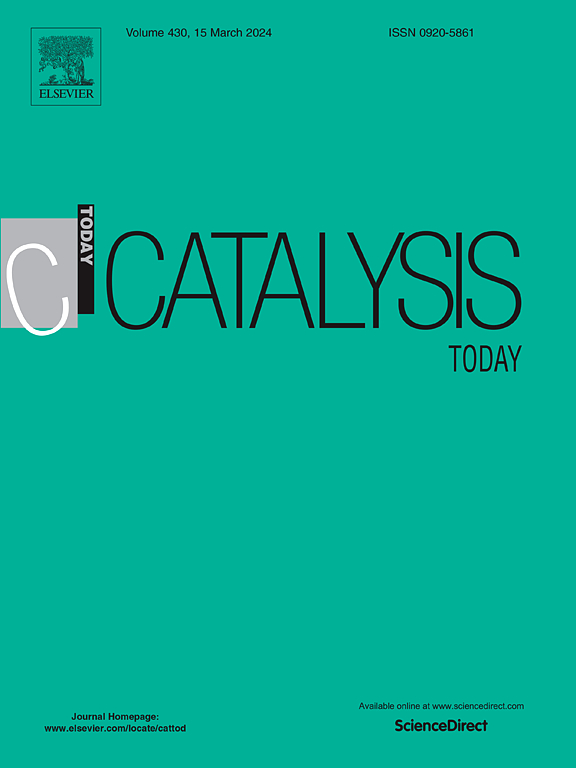环金属化双核铱(III)配合物与2,2'-联吡啶桥接配体作为光化学析氢反应的光敏剂
IF 5.3
2区 化学
Q1 CHEMISTRY, APPLIED
引用次数: 0
摘要
合成了一种新的环金属化双核铱配合物,其具有1,2-二(4 '-甲基-2,2'-联吡啶-4-基)乙烷(bmbe)桥接配体[Ir2(ppy)4(bmbe)](PF6)2 (IrPS-D; ppy = 2-苯基吡啶),有望作为光化学析氢反应的高效光敏剂(PS),并通过1H NMR、ESI-TOF-MS、ATR-FT-IR、元素分析和单晶x射线衍射分析对其进行了结构表征。光谱分析和时变密度泛函理论计算的结合表明:(1)IrPS-D的可见光吸收光谱具有与[Ir(ppy)2(dmbpy)]PF6 (IrPS-M)几乎相同的形状和激发特征;dmbpy = 4,4'-二甲基-2,2 '-联吡啶),是一种众所周知的光化学析氢反应的有前途的PS,也是IrPS-D的单核对应物,而IrPS-D的光谱强度大约是IrPS-M的两倍;(ii) IrPS-D和IrPS-M的发射能量几乎相同;然而,与IrPS-M相比,IrPS-D的发射寿命略短,量子产率略高,因此IrPS-D的辐射和非辐射速率常数相对较快;(3)三乙胺(TEA)对IrPS-D激发态的猝灭作用比IrPS-M更快。在可见光照射下,在K2PtCl4和TEA存在下,IrPS-D作为光化学析氢反应的高效PS, K2PtCl4和TEA分别作为析氢催化剂和牺牲电子给体。IrPS-D的最大析氢翻转数(TONPS)为2672,是IrPS-M (TONPS = 563)的4.75倍。本文章由计算机程序翻译,如有差异,请以英文原文为准。
Cyclometalated dinuclear iridium(III) complex with 2,2'-bipyridyl-based bridging ligand as a photosensitizer for photochemical hydrogen evolution reaction
A new cyclometalated dinuclear iridium complex with a 1,2-bis(4′-methyl-2,2'-bipyridin-4-yl)ethane (bmbe) bridging ligand, [Ir2(ppy)4(bmbe)](PF6)2 (IrPS-D; ppy = 2-phenylpyridinate), which is anticipated to function as a highly efficient photosensitizer (PS) for the photochemical hydrogen evolution reaction, is synthesized and structurally characterized via 1H NMR, ESI-TOF-MS, ATR-FT-IR, elemental analysis, and single crystal X-ray diffraction analyses. The combination of spectroscopic analysis and time-dependent density functional theory calculations clarifies that (i) the visible-light absorption spectrum of IrPS-D exhibits a shape and excitation features almost identical to those of [Ir(ppy)2(dmbpy)]PF6 (IrPS-M; dmbpy = 4,4'-dimethyl-2,2′-bipyridine), which is a well-known promising PS for the photochemical hydrogen evolution reaction and mononuclear counterpart of IrPS-D, whereas the spectral intensity of IrPS-D is approximately twice as high as that of IrPS-M; (ii) the emission energies of IrPS-D and IrPS-M are nearly identical; however, IrPS-D exhibits a slightly shorter emission lifetime and higher quantum yield compared with those of IrPS-M, resulting in relatively faster radiative and non-radiative rate constants for IrPS-D compared with those of IrPS-M; and (iii) the excited state of IrPS-D is quenched by triethylamine (TEA) faster than that of IrPS-M. Upon visible-light irradiation, IrPS-D serves as a highly efficient PS for the photochemical hydrogen evolution reaction in the presence of K2PtCl4 and TEA, which function as the hydrogen evolution catalyst and sacrificial electron donor, respectively. The maximum turnover number (TONPS) of IrPS-D for hydrogen evolution is 2672, which is approximately 4.75 times greater than that of IrPS-M (TONPS = 563) under the same reaction conditions.
求助全文
通过发布文献求助,成功后即可免费获取论文全文。
去求助
来源期刊

Catalysis Today
化学-工程:化工
CiteScore
11.50
自引率
3.80%
发文量
573
审稿时长
2.9 months
期刊介绍:
Catalysis Today focuses on the rapid publication of original invited papers devoted to currently important topics in catalysis and related subjects. The journal only publishes special issues (Proposing a Catalysis Today Special Issue), each of which is supervised by Guest Editors who recruit individual papers and oversee the peer review process. Catalysis Today offers researchers in the field of catalysis in-depth overviews of topical issues.
Both fundamental and applied aspects of catalysis are covered. Subjects such as catalysis of immobilized organometallic and biocatalytic systems are welcome. Subjects related to catalysis such as experimental techniques, adsorption, process technology, synthesis, in situ characterization, computational, theoretical modeling, imaging and others are included if there is a clear relationship to catalysis.
 求助内容:
求助内容: 应助结果提醒方式:
应助结果提醒方式:


